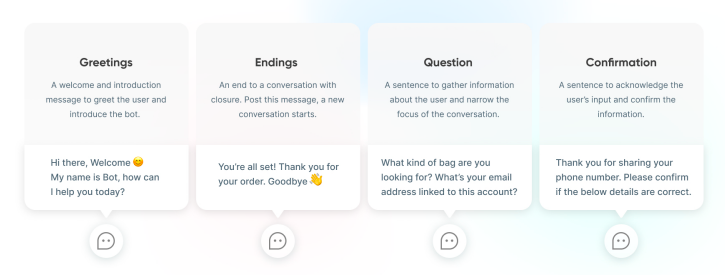In an ideal world, your bot replicates your best salesperson. This requires some nuance, and we understand you must have a lot of questions about how to get the best out of your bot.
We at the Verloop.io team have been building conversational interfaces for quite a while, so given below are some of our best practices that we recommend you use.
We’re serious about our commitment to guiding you through every step.
How to start?
Just like an everyday conversation, your bot should also start with a simple question. This encourages your customers to take initiative to talk to the bot and have a conversation. A complicated or convoluted question or an immediate prompt for identification disincentivizes a potential lead from engaging with the bot.
The ideal questions are equal parts intriguing, and equal parts non-hostile. If you run a children’s clothing website, a prompt that says, “What is your child’s favourite colour?” achieves this goal. It’s a short enough question to engage the visitor and not difficult enough to confuse or demotivate them.
Use a Question Block to ask a question to your visitor. Check our article Build your own recipe to know more about using the blocks.
Set a default response:
Leaving your customer without a response tends to display bad form. Ensure that each message from your visitor is responded to by your bot. And also to keep the conversation going and filter your hot leads, make sure they are asked another question so that the chat continues. This default response can be something as simple as ‘Gotcha’. Crisp and well-thought responses make the conversation seem more personalized and your bot more likeable.
Use button responses:
Button responses allow you to give a set of multiple choice to your visitors, which they can use as an answer, thus making the conversation quicker. With this tool, your visitor has a more enhanced experience while on your website.
Verloop.io allows you to implement these buttons to ensure that the right people go through the right flow. This helps segregate leads based on various factors, like industry or purpose of visit, size of the organization and hierarchical position.
We also like to suggest that the email addresses of your visitors should be taken for future reference.
Use different components of conversations
A good conversation consists of multiple elements. You should mix and match these elements to design your conversational flow for better engagement.



Give your chatbot a personality
You need to sketch a personality for your chatbot – an identity based on your user persona, brand guidelines, the channel of implementation (website, WhatsApp, Facebook or in-app) and the goals it’s set out to achieve. Some of the things you need to keep in mind are if the bot should be formal or informal, serious or fun, verbose or concise, and so on. In short, identify the tone and style of language you would want to use for your chatbot. It will help you establish the emotional quotient of the chatbot that’ll take the whole conversational experience as close to human-like as possible.
Map out the main use cases
Now that you know the purpose of your chatbot and you’ve done your research on the users, you can chart out the topics and use cases you want the chatbot to cater to. This is an important step because no matter how much you try, your chatbot cannot cover all use cases. The key to higher engagement is getting the chatbot to help users solve their problems. So, narrow down the topics to the most important ones and double down on them for instant gratification.
For example, if your eCommerce chatbot’s purpose is to support customers, you need to make a list of use cases that it can support. These could be answering questions on product details, pricing, delivery, refund and returns, etc., sharing updates on order status, retargeting cart abandonment users with solutions for the next steps, allowing users to update personal information, collecting feedback post-purchase, etc.
Keep the edge cases for humans
It’s important to note that chatbots cannot replace humans. Remember the famous 80/20 rule? Chatbots can take care of 80% of your queries – ones which are common and repetitive. For the remaining 20%, where the user doesn’t want to chat with a bot or the query is complex or has high business value. In such scenarios, your users want human assistance. While designing the conversation flow, make sure you give users the option to connect with an agent.
